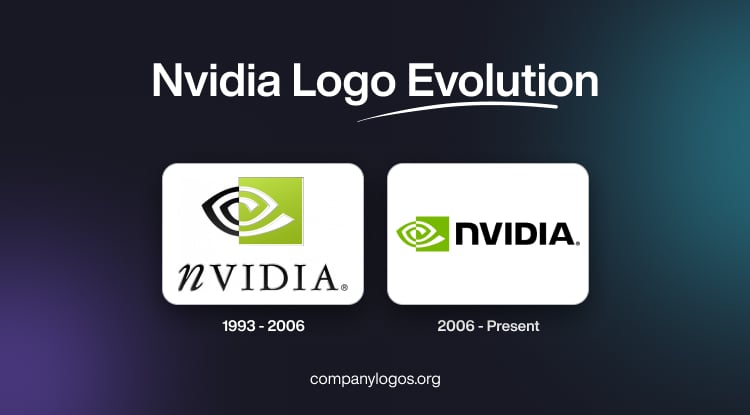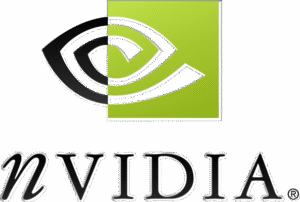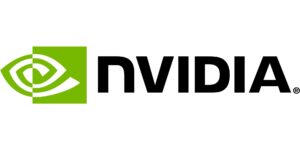
Nvidia is a world-renowned US-based company that makes high-performance GPUs and chipsets. Founded in 1993 in Santa Clara, the company is behind products that are used to drive cars, gaming consoles, computers, and other systems. Besides being a global powerhouse in graphics processing and artificial intelligence, Nvidia has maintained one of the most distinctive and enduring logos in the tech industry. The journey of its visual identity reflects both the company’s vision and its transformation from a niche graphics startup to a dominant force in AI and computing. The article explores the journey of the Nvidia logo, among other details of the company.
The Genesis of the Nvidia Logo (1993 – 2006)
The original Nvidia logo featured the now-iconic “all-seeing eye” since the inception of the company. The original design was a split-eye motif, that is, one half black and white and the other half white with a green square above it. This was paired with a wordmark below in a classical serif typeface in black with silver-grey shadows.
The wordmark “nVIDIA” had a uniquely italicised lowercase “n”. The green and black colour scheme was chosen to symbolise originality, growth, and the company’s relentless pursuit of innovation. The eye itself was a metaphor for vision and forward-thinking. Besides, it aligned with Nvidia’s mission to push the boundaries of computer graphics and technology.

(2006 – Present)
In 2006, Nvidia undertook a significant brand refresh. The eye symbol of the logo was refined, wherein the black half was replaced with green, and the green square became a darker and more saturated shade. The wordmark shed its serif font and italicised “n” in favour of a bold, uppercase Nvidia sans typeface. It represented strength, modernity, and confidence. This update aligned Nvidia’s visual identity with the sleek aesthetics of the digital age. It also supported its growing influence in gaming, professional visualisation, and high-performance computing.

The Elements of the Nvidia Logo
Font
The wordmark shown in the Nvidia logo uses a customised uppercase sans-serif typeface. The corporate logo used a modified Handel Gothic typeface till 2022 and Nvidia Sans from thereon.
Colour
The Nvidia logo uses a green and blue colour to show its emblem and wordmark, respectively.
The History of Nvidia
Nvidia was founded on April 5, 1993, by the trio of Jensen Huang, Chris Malachowsky, and Curtis Priem in Silicon Valley. The trio, with backgrounds at leading tech firms like LSI Logic, AMD, IBM, and Sun Microsystems, met at a Denny’s restaurant to lay the groundwork for a company that would revolutionise computer graphics. Their vision centred on the belief that graphics-based processing would be the key to solving computational challenges that general-purpose CPUs struggled with, particularly in the burgeoning video game market.
Nvidia’s first product, the NV1 graphics accelerator, was launched in 1995. The NV1 was innovative but ultimately unsuccessful, partly due to its incompatibility with Microsoft’s DirectX standard, which favoured triangle-based rendering over the NV1’s quadrilateral approach. This misstep nearly bankrupted the company, but a $5 million investment from Sega, after the loss of a Dreamcast contract, kept Nvidia afloat.
In 1997, Nvidia released the RIVA 128, a graphics accelerator that was optimised for triangle primitives. Besides, it is aligned with industry standards and DirectX. The RIVA 128 was a commercial success and sold over a million units in four months, thereby saving the company from collapse. This success was followed by the RIVA TNT in 1998, which further cemented Nvidia’s reputation for high-performance graphics technology.
Nvidia went public on January 22, 1999. Later that year, it launched the GeForce 256, which was marketed as the world’s first “GPU” (graphics processing unit). It introduced hardware transformation and lighting (T&L) to consumer graphics cards. The GeForce 256 set a new industry benchmark for performance and innovation. The early 2000s saw Nvidia expand rapidly. The company supplied graphics hardware for Microsoft’s Xbox console and Apple’s Power Mac G4. It was also added to the Nasdaq 100 and S&P 500 indices. In 2000, Nvidia acquired the intellectual assets of 3dfx, a pioneer in 3D graphics, to further consolidate its dominance.
A key moment came in 2006 with the launch of CUDA, a parallel computing platform that allowed Nvidia GPUs to be used for general-purpose computing, which included scientific and AI workloads. This innovation marked the beginning of Nvidia’s transformation from a graphics company to a leader in high-performance and AI computing.
Nvidia’s focus on AI accelerated in the 2010s. The introduction of the Kepler (2012), Maxwell (2014), and Pascal (2016) architectures brought major improvements in GPU power efficiency and performance. Nvidia’s GPUs became the backbone of deep learning and AI research. They powered breakthroughs like the AlexNet neural network. In 2017, Nvidia’s Volta architecture introduced Tensor Cores, specialised for AI workloads, and the Turing architecture in 2018 further integrated AI-based enhancements into graphics rendering. By 2020, Nvidia’s Ampere architecture pushed the boundaries of AI and high-performance computing even further.
Nvidia’s influence extends far beyond gaming. The company now commands over 80% of the enterprise AI chip market and continues to innovate in AI, robotics, and autonomous vehicles. At CES 2025, Nvidia unveiled the GeForce RTX 50 Series (Blackwell architecture), the Cosmos platform for robotics, and new AI foundation models for content creation. Technologies like DLSS 4 and the DRIVE Hyperion AV platform demonstrate Nvidia’s leadership in both consumer and enterprise AI.
Nvidia’s corporate culture, which is shaped by Jensen Huang’s leadership, emphasises learning from failure, experimentation, and a flat organisational structure that encourages innovation and agility.
Interesting Facts About Nvidia
- Nvidia was founded on April 5, 1993, by Jensen Huang, Chris Malachowsky, and Curtis Priem in Santa Clara, California.
- The idea to start Nvidia was agreed upon at a Denny’s diner in San Jose, California, in late 1992.
- Nvidia invented the world’s first GPU, the GeForce 256, in 1999. It revolutionised graphics for gaming and multimedia, and it sparked the growth of the PC gaming market.
- The company’s CUDA platform, launched in 2006, enabled GPUs to be used for general-purpose computing. It transformed fields like scientific research, engineering, and AI.
- Nvidia’s Omniverse platform has enabled collaborative, real-time 3D design and simulation across industries such as architecture, automotive, and media.
- Nvidia is a global leader in artificial intelligence hardware and software, with its GPUs powering AI research, autonomous vehicles, and cloud computing.
- In 2024, Nvidia became the world’s most valuable publicly traded company, briefly surpassing Apple, with a market capitalisation exceeding $3.44 trillion.
- The GeForce line is Nvidia’s flagship for consumer gaming, while its Quadro (now RTX A series) and other professional GPUs are used in workstations and supercomputers for industries like healthcare, automotive, and scientific research.
- Over 200 million gamers and creators use Nvidia GeForce GPUs.
- Nvidia’s Tegra chips are used in automotive systems and famously power the Nintendo Switch console.
- Nvidia went public in January 1999, and its stock price saw a dramatic rise after 2020. This reflected its dominance in AI and accelerated computing.
- The company’s headquarters, the Endeavour building in Santa Clara, features a striking crystalline-like canopy roof inspired by the triangle, the fundamental building block of computer graphics.
- In the mid-1990s, Nvidia nearly went bankrupt after early product failures. However, a $5 million investment from Sega’s president gave it a crucial lifeline. The unofficial motto of the company for years used to be, “Our company is thirty days from going out of business.”
- The release of the RIVA 128 in 1997 saved the company, as it sold a million units in four months and funded future innovations.
- Nvidia employs over 36,000 people in 38 countries and has more than 8,700 granted and pending patents worldwide.
- The company has been recognised as one of America’s Best Companies (Forbes 2025), one of the World’s Most Innovative Companies (Fast Company), and one of the Best Places to Work (Glassdoor 2025).
- The triangle is a recurring motif at Nvidia, both in its technology (as triangles are the basic unit of 3D graphics) and in the architecture of its headquarters.
Finally
The Nvidia logo has evolved in subtle but meaningful ways. However, it has always retained its core symbolism of vision, innovation, and leadership. The enduring “all-seeing eye” has become a beacon for the company’s relentless drive to shape the future of technology. The logo has thus become one of the most recognisable and respected marks in the industry.